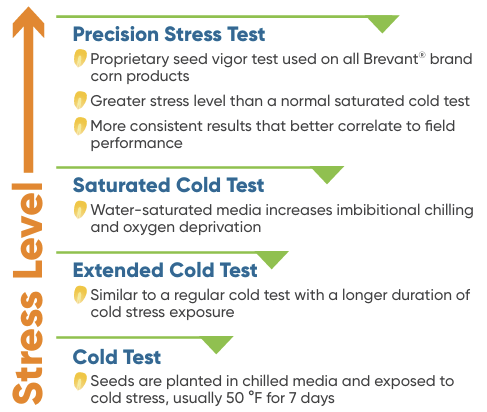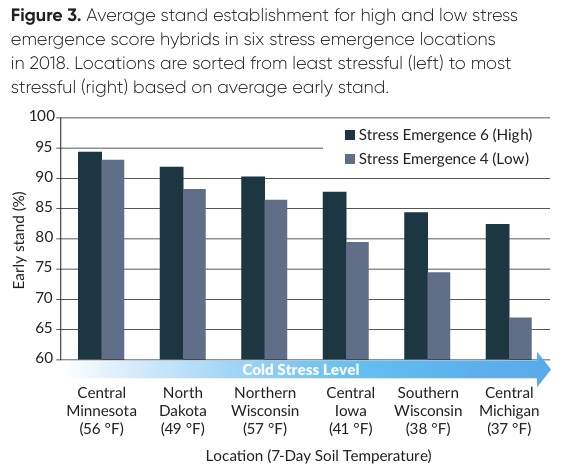KEY POINTS
The Precision Stress Test (PST) is a proprietary vigor test used on all our corn products.
Precision Stress Test and field trial results are used to assign stress emergence ratings that characterize a hybrid’s genetic potential to tolerate cold, wet conditions and germinate normally.
The Precision Stress Test allows for optimal characterization of seed quality, which helps to ensure growers get the highest quality seed for planting.
COLD GERMINATION TESTS
Successful germination and emergence of corn is determined by three primary factors: environmental conditions, hybrid genetics, and seed quality (Figure 1).
In North America, corn is nearly always subjected to some degree of environmental stress during germination and emergence.
Corn is a warm season crop, with an optimal soil temperature range for germination and emergence of 85-90° F (29-32° C).
Soil temperatures at planting are usually below, and often well-below, this range.
The need for corn to tolerate stressful environments during germination and emergence means genetic vigor and seed quality are both critical for establishment of a successful crop.
Corn vigor tests have been used for decades to simulate stressful soil environments and assess the ability of hybrids and specific seed batches to germinate under those conditions.

The Association of Official Seed Analysts (AOSA) defines vigor as those seed properties which determine the potential for rapid, uniform emergence, and development of normal seedlings under a wide range of field conditions.
Lab assays to test vigor are commonly referred to as cold tests. Different variations of cold tests have been in use in the seed corn industry since the 1950s.
In North America, the most commonly used vigor tests are the cold test and saturated cold test.
A cold test typically consists of planting seeds in chilled media and maintaining them at low temperature, usually 50 °F for 7 days, followed by a grow out period at a higher temperature to assess germination.
An extended cold test is a variation offered by some labs with a longer duration of cold stress.
A saturated cold test increases the stress level by using water-saturated media, which increases imbibitional chilling and oxygen deprivation. Seeds are often placed embryo side down in order to increase overall stress levels.

Unlike warm germination scores, which are derived using an industry-wide standard protocol and required by law to be reported on bag labels, cold test methodologies are not standardized and may vary among labs.
Consequently, a cold test or saturated cold test score does not constitute an objective performance rating that is comparable across labs, but rather must be interpreted relative to the specific protocol that was used.
PRECISION STRESS TEST
The Precision Stress Test (PST) is a proprietary vigor test used on our corn products.
It was developed in the early 2000s as an improvement upon the saturated cold test.
The Precision Stress Test imposes extreme imbibitional chilling and anaerobic stresses, beyond that of the saturated cold test.
The Precision Stress Test has proven to be more predictive of hybrid performance under extreme cold stress and to provide better differentiation among genetics and seed lots (Figure 2).
A good vigor test is one that is rapid, reproducible, objective, and correlated to field emergence under stressful conditions.
FIELD VALIDATION
The Precision Stress Test is continually validated in field research trials.
Early-planted stress emergence trials are conducted every year across multiple locations.
Research sites are chosen to reflect the various seedbed and environmental conditions likely to be experienced by farmers.
Some eastern locations often have extended cold and wet conditions that persist into late spring and early summer.
Northern and Midwestern sites are more likely to provide extreme day/night temperature fluctuations.
Field validation has shown that the PST produces consistent, reproducible results that strongly correlate to field emergence under stress (Figure 2).
STRESS EMERGENCE SCORES
- The Precision Stress Test is used to support hybrid advancement decisions and also to support breeding efforts to improve early season stress tolerance through marker-assisted selection.
For hybrids that are advanced to commercial status, Precision Stress Test and field trial results are used to assign stress emergence ratings that characterize a hybrid’s genetic potential to tolerate cold, wet conditions and germinate normally.
Figure 3 shows differences in emergence between two hybrids with differing stress emergence ratings in several field trials that experienced cold stress after planting.

ENSURING SEED QUALITY
Corteva has the seed industry’s highest production and quality control standards, assuring growers they get the highest quality seed for planting.
The Precision Stress Test allows for optimal separation between high and low quality. It can detect small differences in vigor that may indicate a seed lot needs to be discarded.
The Precision Stress Test has the ability to detect imminent standard (warm) germination failures in seed lots.
Testing Points
New crop seed is tested in the fall at harvest to determine the initial quality.
After conditioning, all seed sizes of each sizing run are tested again; all seed sizes must meet the same high-quality criteria.
Carryover seed must meet the same quality criteria as new crop seed. Corteva does not differentiate between new crop and carryover when evaluating test results.
Customers can be confident that every batch they plant has been thoroughly tested in this extensive screening program and meets Corteva’s industry-leading standards.
